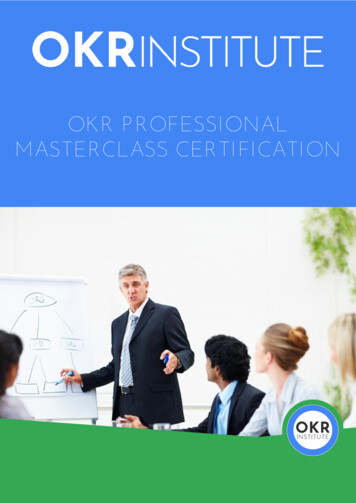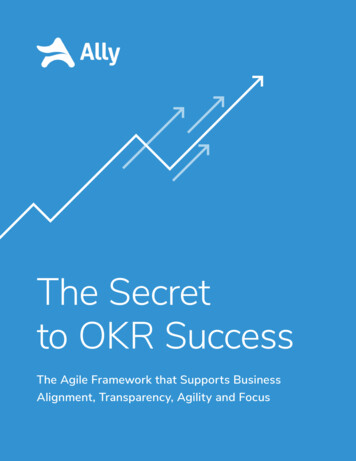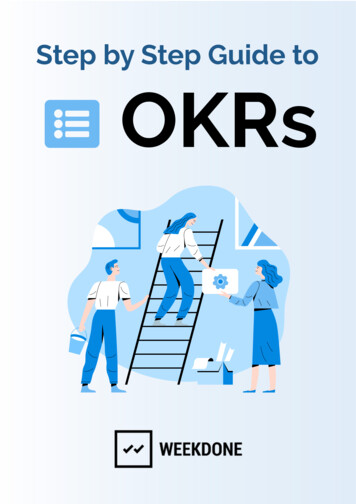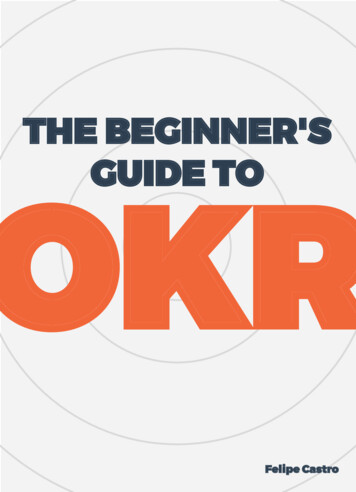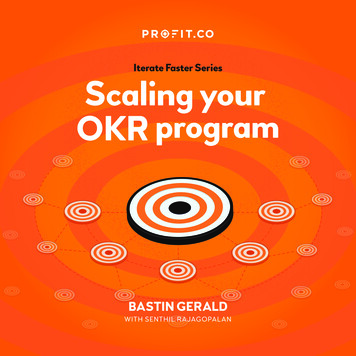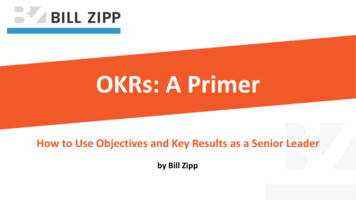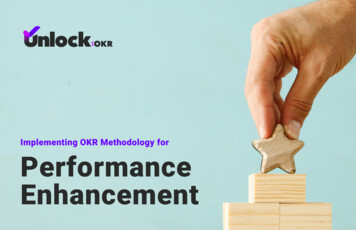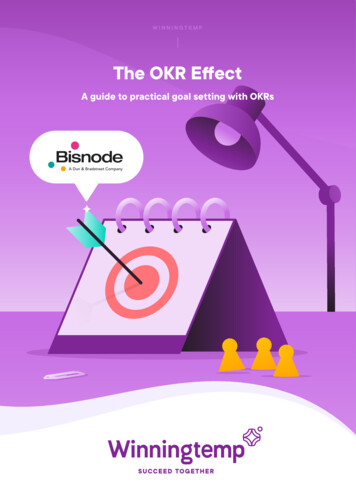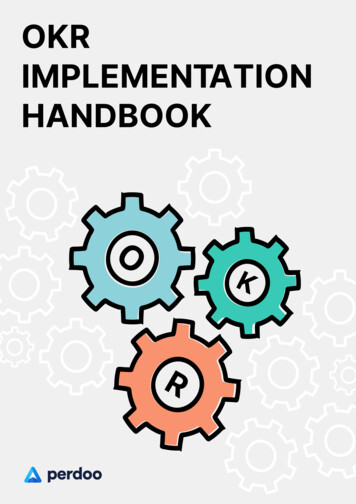
Transcription
OKRIMPLEMENTATIONHANDBOOKOKR
Copyright2021 by Daniela PeraltaAll rights reserved. No part of this book may be reproduced or usedin any matter without prior written permission of the copyright owner,except for the use of quotations in a book review.First edition: 29th March 2021Published by Perdoo GmbHwww.perdoo.com
IntroductionYou’ll need planning and coordination to successfully roll out OKR andPerdoo “to a T”, so we’ve put together the important steps to save youtime and make sure it’s a success.The handbook is divided into 5 sections with brief introductions ofwhat you need to do, followed by a recommended read if you’d liketo dig deeper into a topic. We’ve also added checklists at the end ofeach section to help you stay organized. This guide is based on ourrecommended four-week rollout of OKR and Perdoo, but that timeline isreally down to you. Need a little more time? No sweat! Our proposal isflexible enough to adapt to your needs.We look forward to supporting you to turn a great strategy into amazingresults. Let’s go!Implementation timeline
ContentsPrepare Assign a program Ambassador Define participating Groups Define Cadences & Timeframes Check-in & progress review frequency Documenting your Process Introduce Benefits of OKR Explanation of Perdoo An introduction to the Ambassador Next steps and deadlines Train OKR methodology Perdoo Reading material for Leadership Create Ultimate Goal, Strategic Pillars & KPIs Company OKRs Group KPIs Group OKRs Identify interdependencies Managers approve OKRs Launch Check-in on your goals regularly Use 1:1s to stay on top of progress Quarterly All Hands meetings clusion 29Implementation checklist 30
PrepareDesign your OKR programTo kick off your implementation, you’ll first have to create a foundationthat will guide the process throughout every quarter. This will ensurethat people have guidelines to follow and the necessary support to makethe transition much simpler. It’s really important that the establishedprocess is governed and constantly reinforced by leadership andmanagement.Assign a program AmbassadorIntroducing OKR into an organization will involve some changemanagement since you’ll be adjusting how people think and work.The Ambassador is the person you’ll choose to spearhead this change.Together with the support of leadership, they will manage the OKRprogram and act as the OKR expert within the company. Some of theAmbassador’s responsibilities include:Leading the OKR implementationCreating processes and ensuring they’re being followedAssisting teams to create/close OKRsAdministrating the Perdoo softwareCoordinating with your Perdoo Coach for tutoring and mentoringsessions (when applicable)Learn more about the Ambassador role.5
Define participating GroupsUnderstanding which teams will participate in the OKR program isanother decision you’ll need to make at the beginning (and adapt lateron as you learn). Groups let you organize your goals (as well as yourpeople). Groups enable you to keep track of how certain areas of yourbusiness are performing. Create groups in Perdoo based on the teamsthat are critical for supporting the company strategy and thereforeexecute on a quarterly cadence through OKRs.There are 3 common ways to organize your groups:1. Functional. These groups match your organization’s structure andit’s the most commonly used one (ie. Marketing, Sales, Finance,etc.).2. Cross-functional. Distributes the workload based on specific topicsthe organization wishes to tackle. These could be groups that areformed to solve specific problems in the organization, or groupsaround specific products, etc.3. Hybrid. This is a combination of the two options above.Some organizations decide to gradually roll out OKR. They start witha few groups, collect feedback, make changes and then extend theprogram to the next set of groups. Other organizations roll out to allgroups simultaneously. If you decide to do the latter, make sure not torush the process and that you have a clear and solid roll-out plan tokeep things organized.Learn more about the groups.6
Define cadences & timeframesDefining how often you’ll be creating goals both at company and teamlevel is a basic step to any OKR program. This decision communicateshow often you’d like people to deliver results. The standard structure ishaving annual company-level OKRs and quarterly team OKRs (to keepthings agile), but this of course can be adapted to your organization’sneeds.The idea is to work with a combination of cadences that interact witheach other to create a rhythm of continuous and focused progress, somake sure to choose 2 cadences. You want to have high-level goalswith a longer horizon that can only be accomplished by working towardsmaller goals with a shorter horizon.Once you’ve decided this, create Cadences & Timeframes in Perdoo.Learn more about cadences.Check-in & progress review frequencyA well-designed OKR program provides clarity on what you expect andwhen you expect it to happen. A huge pitfall of new OKR programs isthe “set it and forget it” mentality. People create goals but then neverfocus on actually achieving them, so more often than not, the executionfails. To ensure execution succeeds, clearly define a frequency at whichpeople need to update progress on their goals, in Perdoo, Slack, MSTeams, or via the Perdoo mobile app. This cadence will need to bereinforced by the Ambassador, leadership and managers, especially atthe beginning and until it becomes second nature. (More on this topicbelow: "Check-in on your goals regularly"). Progress on quarterly OKRsshould be updated on a weekly basis (recommended), or no longer thanevery two weeks.7
Configure this update frequency in Perdoo. This will trigger an automaticemail reminder to everyone who leads a goal and hasn’t Checked-into update it. It will also mark goals that haven’t been updated in thistimeframe as “outdated” so both the Ambassador and managers cantake necessary action.8
In addition to having a defined frequency on when to update goalprogress in Perdoo, you’ll need to reinforce execution by also defininghow often you’d like to review progress on goals at all levels. Considerthe following:When and how often should teams discuss progress on their OKRs?(Don’t create new meetings, use existing ones.)When will leadership meet to discuss the health of the execution ofthe active quarter? (We recommend monthly.)When will progress on Company OKRs be reviewed? (We recommendquarterly, with results shared with the entire organization.)Learn more on defining a frequency to update your goals and reviewprogress.9
Document your processOnce you’ve decided how your OKR process will look, make sure youdocument and communicate it so that everyone in the organizationknows what’s expected.Your process should include:By when should OKRs be approved and added to Perdoo (everyquarter)Check-in frequency in PerdooProgress review frequencyBy when should OKRs be closed once the quarter endsDownload a template:PowerPointKeynotePreparation checklistAppoint an AmbassadorDefine participating GroupsDefine cadences & timeframesCheck-in & progress review frequencyDocument your process10
IntroduceAnnounce OKR Perdoo to your organizationAlongside your planning phase you’ll have to announce the decision towork with OKR at the company. Change means modifying your habitsand people naturally resist this, so good communication is necessaryto motivate them to step outside of their comfort zone. This is yourchance to explain the value that OKR will bring to the organization andthe individuals. Most organizations send an official email announcingthis followed by an All Hands meeting to dive deeper into the topic,communicate the rollout plan, and answer any questions.Your communication should include the following:1. Benefits of OKR.Explain WHY OKR and HOW it will help the company transform.Describe the benefits OKR will bring to both the company ANDindividuals, for example, alignment and transparency.2. Explanation of Perdoo.People need to know about the tool that will support this change.Make a brief introduction (example below) and share this video."Perdoo’s software allows us to easily manage and track our OKRs andKPIs. Perdoo’s mission is to help organizations turn their strategies intoresults. Over the past 6 years they’ve helped hundreds of organizationslike ours."3. An introduction to the Ambassador and how they’ll support theprogram.11
4. Next steps and deadlines.Share training dates and deadlines for when everyone needs tocreate their OKRs (the process document you developed in theDesign your OKR program section)Learn more about why it's important to announce OKR & Perdoo.Introduction checklistDraft email announcement of Perdoo and OKRCommunication approved and sent from the CEO’s emailSchedule an All Hands meeting to follow up on the email announcement12
TrainLearn about the OKR methodology and how to usePerdooNow that you’ve prepared and announced OKR & Perdoo to yourorganization, you need to start putting down some dates to kick-offyour program. The first thing to define is when and how you’ll train youremployees on OKR and Perdoo. OKR is a new language. Let’s make surethat everyone’s speaking that same language to avoid confusion. Themost popular format is online training because it’s more scalable andcost effective, but some organizations opt for internal workshops. We’veseen both methods work really well, and the good news is that Perdooprovides you with free and paid resources to support your needs:OKR methodologyThe Ultimate Guide to OKREverything you need to know about KPIs, Objectives, Key Results, andInitiatives.Learn moreOKR Crash CourseAn unmatched overview of OKR and KPIs in 12 minutes.Watch video13
OKR 101 online training (most popular)Perdoo Premium customers, get a 50% discount on our online course,and Perdoo coaching customers get the course for free! It helps anyoneinterested in OKR to become outcome-oriented and master the OKRframework in minutes, not months.What's included:13 videos of original learning content5 sections of science-backed goal-setting tips4 quizzes to put new learnings to the testA certificate of completion for each userVisit courseCoaching packagesNeed extra support? You can work 1:1 with a coach who specializesin the OKR framework. They’ll guide you through a successfulimplementation and ensure that your program follows the best practices.Learn morePerdooIntroduction to PerdooVideo overview of the Perdoo platform in 4 minutes.Watch video14
Reading material for LeadershipIn addition to the standard OKR and Perdoo training, we recommend thatleadership also goes through the following reading material, to supportthe creation of a comprehensive Roadmap to success.1. Put strategy first, OKR second2. The ultimate guide to KPIs3. The growth handbook for CEOs4. The ultimate guide to OKRTraining checklistSend eBooks to leadershipPrepare OKR & Perdoo training materials (buy online access or developinternal curriculum)Determine training deadline for executives, managers and team membersTrain executives on OKR & PerdooTrain managers on OKR & PerdooTrain team members on OKR & Perdoo15
CreateLeadershipA good Roadmap begins with an Ultimate Goal, followed by StrategicPillars, KPIs, and finally Company OKRs. All of these elements willprovide enough context so that people focus on what matters most.Ultimate Goal, Strategic Pillars & KPIsMany organizations are implementing OKR in order to improve alignmentacross their organization. They want to make sure everyone is pulling inthe same direction. But for OKR to boost alignment, you first need to getyour strategy in place.Strategy matters because each organization has finite resources andfaces competition. To win over the competition you first need to decidewhich battle(s) you want to fight and what winning looks like.Your strategy (ie, your Ultimate Goal and Strategic Pillars) will serveas the foundation that will inspire all the KPIs and OKRs that yourorganization will be working on. That’s why it’s so important to track yourstrategy and goals in the same place: it enables everyone to see thebigger picture and if what they’re doing is aligned with it.16
To set your strategy, leadership needs to:Define the Ultimate Goal. The Ultimate Goal is a combination of yourmission and vision, which defines the purpose of your organizationand for whom you’re fulfilling this purpose.Define Strategic Pillars. Strategic Pillars express how you’lldifferentiate in the market, why customers will choose you overcompetitors.Define KPIs. Your strategy is practically eternal, so the success of aStrategic Pillar is measured through KPIs. With your Strategic Pillarsset up, you’ll need to decide how you'll measure their success. WhichKPIs will you use to monitor each Strategic Pillar on an ongoingbasis?Leadership will need to dedicate time to discuss and decide on thestrategy, so schedule a couple of sessions to ensure they allocateenough time to make these decisions. Once defined, start populatingyour Roadmap by adding the Ultimate Goal, Strategic Pillars, and KPIs.Learn more about adding Strategic Pillars in Perdoo.17
Company OKRsCompany OKRs narrow down the scope of your strategy translatingit into smaller, actionable steps. Strategy is ongoing and the optionsfor making it a reality are unlimited. Company OKRs simply reduce theoptions and make execution concrete and directed. They express theresults you need to achieve within a year to continue to move forward.Company OKRs:Should be high-level enough so that they can be influenced by themajority of your teams. If only one team will drive it, then it’s likely ateam level OKR.Break the status quo and help the company evolve.As soon as they’re ready, add Company OKRs to Perdoo before movingon to Group OKRs.Learn more about Company OKRs.18
GroupsOnce your strategy is in place and has been communicated to theorganization, your full attention will shift to the different groups (teamsor departments) in your organization. By looking at the strategy andannual Company OKRs, it’ll be the groups’ turn to define their KPIs andformulate quarterly OKRs.Group KPIsTeams and departments will always have to organize their work betweenbusiness as usual and OKRs, therefore you need visibility on both KPIsand OKRs to keep everything in perspective. KPIs or Key PerformanceIndicators, help you measure the health of your business as usual, whileOKRs help you transform the business. Once they’re tracked together inone tool, you get full transparency on the priorities of each area of yourbusiness.When selecting KPIs for a group, map out their core responsibilities andthen decide what KPI will help you measure that more effectively. Youcan check our OKR & KPI library for inspiration.When ready, ask team leads/managers to add their KPIs to Perdoo.Learn more about KPIs vs. OKRs.19
Group OKRsContrary to Company OKRs, Group OKRs communicate how a team ordepartment will help the company achieve its annual goals. Group OKRsare typically delivered in a quarter and put the group’s work into thecontext of the impact they create in the business. Quarterly OKRs iswhere all the action happens, so they have a more agile and dynamicnature. In addition to Objectives and Key Results, Group OKRs areusually supported by Initiatives, which are all the things you’ll be doingin order to achieve your Key Results.During the first few cycles of your OKR program, it’s important to checkthat teams are scheduling time to define OKRs and KPIs. Participate intheir meetings to guide them through the process and share questionsthat can help them start discussions needed to decide on what to focuson. Many feel lost at the beginning (it’s okay!), so a guiding hand will bemore than welcome.When defining OKRs, it’s best practice to answer the following: “Why isthis important? Why is this urgent?”. These questions will give you moreperspective as to whether or not you have the right priorities in place.It will also help others understand what you’ve decided to prioritize andwhy.When creating OKRs, the OKR template in Perdoo will automaticallyprompt people to answer these questions in the description section.After saving, the notes will be visible in the Objective page.20
You can also customize the questions if needed:Once the first draft of OKRs is ready, team leads/managers should addOKRs to their corresponding Group in Perdoo, mark the Objective as“draft” to make people aware it’s still pending approval.21
Learn more about Group OKRs.Identify interdependenciesOnce priorities have been identified at the group level, set up a meetingwhere all team managers present their team OKRs. The purpose of thismeeting will be to create alignment of course, but also to identify ifthere are any overlaps or interdependencies between groups. Time andresources are limited, so it's important to openly communicate with otherteams to ensure that they also have the capacity to contribute to othersOKRs. During the meeting, allocate resources where possible or findalternatives if these are limited.Managers approve OKRsTo ensure there’s both vertical and horizontal alignment, we encourageteam leads to discuss their OKRs with their direct managers toguarantee all parties are on board with the defined priorities for thequarter. Once OKRs are approved, the OKR lead can simply “activate”the OKR to indicate the OKR is ready and final.22
Creation checklistSchedule workshops for executives to discuss and define StrategicPillars, create Company OKRs & define KPIs (you might need 2 sessions)Schedule call with Perdoo coach (when applicable) & executives toreview Strategic Pillars, Company OKRs & KPIsSchedule All Hands meeting to introduce Strategic Pillars, CompanyOKRs & KPIs to the organizationDefine and communicate deadlines for teams to define OKRs &KPIs,and add them to PerdooSchedule calls with team leads and Perdoo coach (when applicable) toreview Group OKRsParticipate in teams’ KPI & OKR meetingsMonitor progress on the creation of team OKRs to stick to your deadlinesSchedule meetings with team leads/managers to discuss andresolve interdependenciesTeam OKRs are reviewed and approved by the Managers23
LaunchExecutionWhen strategy has been defined, KPIs & OKRs have been created andadded to Perdoo, it’s time to get the ball rolling. Execution officiallybegins. The focus shifts to ensuring people adhere to the establishedprocess and continue to progress week by week.Check-in on your goals regularlyOur data shows that employees who regularly updated progress on theirgoals achieved on average 2 times more of those goals. Other researchalso shows that progressing towards a goal significantly boosts joy andmotivation.Encourage teams to use Perdoo’s Check-in feature to update all of theirresponsibilities from a single page. This will make things more efficientfor them and will also keep everything up to date to keep managersinformed on progress.If you use Slack or Microsoft Teams, you can easily Check-in withoutever leaving these tools. Find out more about these integrations here.Keeping goals updated on a (bi-)weekly basis, will ensure that yourexecution remains healthy and will therefore increase your chances ofsuccess. Enforcing this practice during the first 3 months of your rollout,will help you create the habit needed to increase the adoption of bothPerdoo and the methodology.24
Use the Engagement report to monitor outdated goals.You can also use the Results tab in Explore to view when a Result waslast updated. You can “Add filters” to find the goals that you care about,save that view, visualize the results on the Charts View, and export aCSV file if you’d like to dig into the data even more.25
In addition, group members and anyone who has bookmarked a group,can monitor progress with the Weekly Progress Report, when enabled.This report offers an actionable snapshot of the health of the group’sKPIs, plus progress on Objectives and a summary of updates in the pastweek.Learn more about the importance of keeping goals up to date.26
Use 1:1s to stay on top of progressOne of the biggest challenges of an OKR program is ensuring peoplestay on top of their goals and that goals are kept up to date. That is whywe highly recommend that managers frequently review progress on teamOKRs, and that they discuss responsibilities with their direct reportsduring 1:1s.We’ve made it easy for managers to stay on top of this by adding a listof their direct reports to their home screen. From there, they can monitorwhether or not their direct reports have submitted their weekly Checkins. During their 1:1s, they can go to the person’s personal profile andthen pull up the Check-in report to facilitate the conversation. By doingthis, managers not only stay informed on how things are developing butthey also create accountability and communicate expectations.Learn more on how 1:1s can help your people achieve their goals.27
Quarterly All Hands meetingScheduling quarterly All Hands meetings has several purposes:Keep everyone informed on Company OKR progressShare learnings and achievements during the quarter (per team)Share focus for the next quarter (per team)Set expectations and create accountabilityRecognize achievements!Quarterly All Hands meetings will also help you to continue to motivateyour team and show them how their hard work is paying off. It willenforce alignment but most importantly, will continue to give everyemployee purpose and take pride in their hard work.Learn more on quarterly All Hands meetings.Launch checklist (3-6 months)Ambassador weekly check: have all goals been updated?Ambassador monthly check: are managers discussing goals during 1:1s?Ambassador schedules meetings to assist teams that are struggling28
ConclusionTo conclude, having a well-defined plan to roll out your OKR programwill make all the difference in how successful you are. Take your time.Don't rush the process! Structuring your OKR program, documentingthe process and communicating it will set the stage for the followingmonths. This is the most important part because it’ll be your foundation,and if a foundation isn’t solid, the building typically collapses.In the months following the rollout, you’ll need to monitor how theprocess is working and adjust as necessary. Ask for feedback. Mostimportantly, you’ll have to ensure everyone is following the process untilit becomes second nature. It's important to keep a learning mentality —nobody gets OKRs right the first time. Creating OKRs won’t be perfectat the beginning, but it’s something that will improve over time. To start,pay more attention to re-enforcing the process and once that’s solidified,you can focus on improving the quality of the OKRs. Persistence andcuriosity matter when improving the process.29
Implementation checklistPrepareAppoint an Ambassador?Define participating GroupsDefine cadences & timeframesCheck-in & progress review frequencyDocument your processIntroduceDraft email announcement of Perdoo and OKRCommunication approved and sent from the CEO’s emailSchedule an All Hands meeting to follow up on the email announcementTrainingSend eBooks to leadershipPrepare OKR & Perdoo training materials (buy online access or developinternal curriculum)Determine training deadline for executives, managers and team membersSend eBooks to leadershipTrain executives on OKR & PerdooTrain managers on OKR & PerdooTrain team members on OKR & Perdoo30
CreateSchedule workshops for executives to discuss and define StrategicPillars, create Company OKRs & define KPIs (you might need 2 sessions)Schedule call with Perdoo coach (when applicable) & executives toreview Strategic Pillars, Company OKRs & KPIsSchedule All Hands meeting to introduce Strategic Pillars, CompanyOKRs & KPIs to the organizationDefine and communicate deadlines for teams to define OKRs &KPIs,and add them to PerdooSchedule calls with team leads and Perdoo coach (when applicable) toreview Group OKRsParticipate in teams’ KPI & OKR meetingsMonitor progress on the creation of team OKRs to stick to your deadlinesSchedule meetings with team leads/managers to discuss andresolve interdependenciesTeam OKRs are reviewed and approved by the ManagersLaunchAmbassador weekly check: have all goals been updated?Ambassador monthly check: are managers discussing goals during 1:1s?Ambassador schedules meetings to assist teams that are struggling31
Introducing OKR into an organization will involve some change management since you’ll be adjusting how people think and work. The Ambassador is the person you’ll choose to spearhead this change. Together with the support of leadership, they will manage the OKR program and act as the
